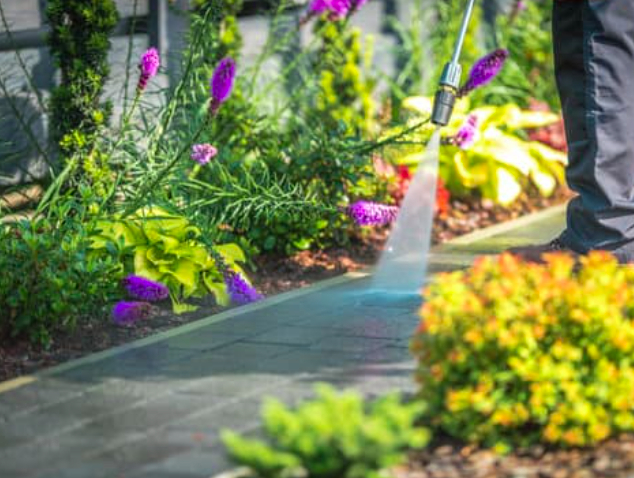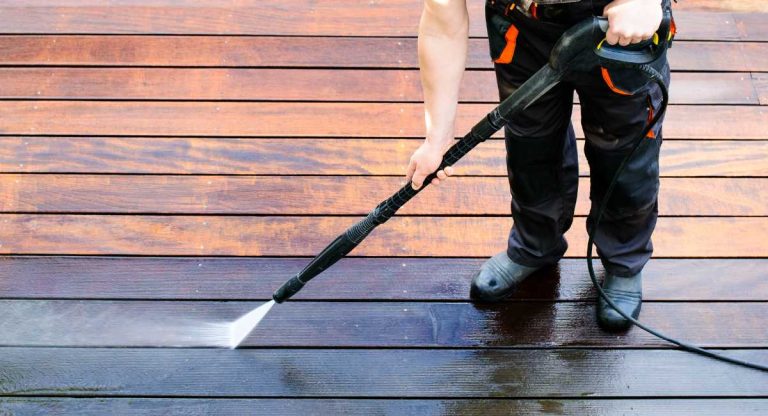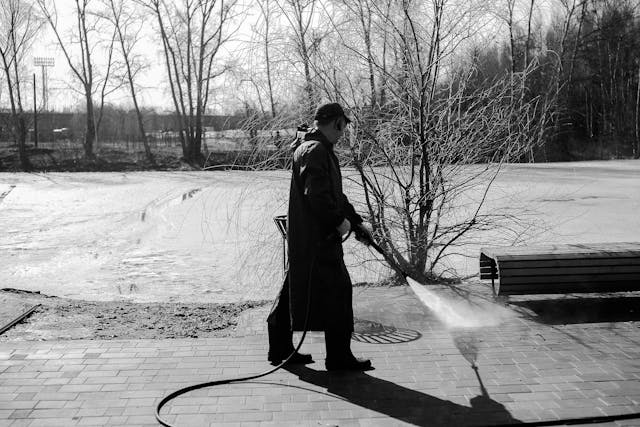
If you’ve put time, money, and love into your landscaping or garden, the last thing you want is for a power washing job to ruin it all. Hiring a power washer isn’t just about getting clean surfaces — it’s also about protecting your greenery, flowers, mulch beds, and delicate landscaping features. 🌸
In this article, we’ll walk through how to safely coordinate power washing around your outdoor living spaces so you get sparkling surfaces without sacrificing your hard-earned curb appeal.
🪴 Why Landscaping Needs Special Attention
Power washers use highly pressurized water — sometimes mixed with detergents — to clean surfaces. While this is great for siding, patios, and driveways, that same pressure or chemical runoff can damage:
- Flowerbeds and shrubs
- Delicate plants and herbs
- Freshly laid mulch or soil
- Decorative garden features
- Lawn edging or irrigation systems
Even if a technician is careful, overspray or runoff can unintentionally drench your greenery with detergents or erode areas near garden beds. That’s why proactive planning is so important. 🛡️
✅ Step 1: Choose a Company That Cares About Landscaping
Not all power washing companies understand the value of protecting landscaping. When getting quotes, ask:
- Do you take precautions to protect plants and garden beds?
- What cleaning agents do you use — are they biodegradable or plant-safe?
- Will you cover landscaping features with tarps or barriers?
A reputable contractor will acknowledge the risk to plants and already have solutions in place. If they brush off your concerns, it’s a red flag. 🚩
🌱 Step 2: Schedule at the Right Time
The timing of your power washing job can make a big difference. Ideally, schedule it:
- Before planting season if you’re planning a big garden install
- During cooler mornings to reduce evaporation and runoff issues
- After a dry spell so the ground can absorb water without becoming muddy
Try to avoid power washing after recent landscaping upgrades (like fresh mulch or new sod) so it doesn’t get blasted away or damaged. 🧼🚫
🏡 Step 3: Prepare Your Yard Before the Crew Arrives
Before your power washing appointment:
- Water all plants thoroughly: Well-hydrated plants are more resistant to chemical damage
- Cover delicate plants or flowers with plastic sheeting or drop cloths
- Move potted plants or hanging baskets away from the cleaning area
- Mark sprinkler heads, wiring, or garden lights to avoid accidental damage
- Secure decorative items like garden statues or birdbaths
These small steps go a long way in keeping your yard intact. ⛱️🌼
🧴 Step 4: Understand What’s in the Cleaning Solutions
Many power washing services use soaps or detergents to loosen dirt and grime. But not all solutions are the same. Ask your contractor:
- Are your cleaners biodegradable?
- Will the runoff affect nearby grass or flowers?
- Can you use plain water or vinegar-based solutions near my garden?
Some companies offer eco-friendly detergents that are safer for plants and soil. 🌿🌍 Always ask what’s being used — if they’re vague, that’s not a good sign.
Browse Amazon Here For Biodegradable Pressure Washing Detergents
🧱 Step 5: Know Which Surfaces Require Extra Caution
Some areas near landscaping need a gentle touch:
- Wooden fences or decks near plants should be soft washed to prevent runoff damage
- Gravel or dirt paths can easily wash out
- Raised beds or retaining walls might have vulnerable edges or gaps
Let your contractor know about any special garden features, like edible plants or irrigation lines. They can adjust their technique accordingly. 🧑🌾
💬 Communicate Clearly With Your Contractor
On the day of the job, take five minutes to walk the yard with your technician:
- Point out delicate plants or sensitive areas
- Clarify which spaces need cleaning — and which to skip
- Confirm where runoff will go and how it will be managed
Most contractors will appreciate your input, and this reduces any guesswork on their end. 🤝
🌧️ Step 6: Prepare for Runoff and Drainage
Water from power washing needs somewhere to go. In a landscaped yard, this can lead to:
- Erosion of soil or mulch beds
- Standing water near roots or garden borders
- Saturation that leads to rot or root damage
Ask your contractor to angle runoff away from landscaping and ensure water doesn’t pool around garden edges. If you have French drains or dry wells, make sure they’re clear before the job. 💧
🧹 Step 7: Post-Wash Garden Care
After the job is done:
- Remove any tarps or coverings right away to avoid cooking plants underneath
- Rinse off any plants that may have gotten misted with detergent
- Check the soil moisture — you may need to re-water
- Rake displaced mulch back into place
- Inspect for damage to delicate edging or fixtures
These steps help your yard bounce back quickly. 🌷💪
🧠 Final Thoughts: Balance Curb Appeal and Plant Health
Power washing and beautiful landscaping can absolutely coexist — you just need to coordinate. When done right, you’ll get:
- Clean walkways and siding
- A sparkling driveway
- Healthy, thriving plants
- Peace of mind that your home and yard are protected
The key is hiring a company that takes both jobs seriously: making your home shine and respecting your green space. 🌿🏠💦
Browse Amazon Here For Top Rated Power Washers And Accessories






